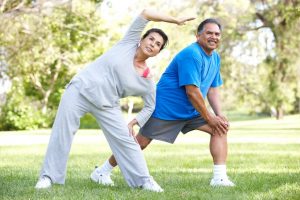
It has long been believed that stretching prior to exercising helps prepare the muscles for activity. Stretching after a workout helps aid in recovery.
Jan Schroeder, chair and professor of fitness in the department of kinesiology at California State University, Long Beach, explained, “There’s a lot of controversy surrounding stretching right now. Out of all of the kinds of activity, stretching [recommendations from the American College of Sports Medicine] have probably changed the most frequently because we’re still learning a lot about it.”
Devon Blackburn, registered kinesiologist, said, “Stretching allows our bodies to achieve resilience and mobility. Health Canada tells us that we need to get cardiovascular exercise for heart health and that women need to work with weights to prevent osteoporosis, but we don’t hear about stretching. From my perspective, if we don’t have the flexibility [afforded by stretching], we can’t do the cardio or muscular strength training. It’s foundational in terms of movement.”
There are two main types of stretches, dynamic and static. Dynamic stretching is often completed prior to a workout and static stretching post-workout. Dynamic stretching helps stimulate the nervous system where static stretching promotes relaxation of the muscles.
Dynamic stretching can help reduce the risk of joint injuries. Dynamic stretching involves going through motions that the activity you’re about to perform requires. For example, you will often see basketball players performing shoots prior to a game. Dynamic stretching should adhere to whatever activity or exercise you’re about to perform. For example, if you’re about the play soccer, perform stretches that target the legs.
Static stretching allows for the release of muscle tension. Tense muscles take longer to recover, so you can feel sore for much longer. Furthermore, studies have shown stretching can improve muscle growth as well.
Yoga has seen a great boost in popularity as many people are now beginning to recognize the benefits of stretching as it can improve range of motion, flexibility, blood flow, and reduce aches and pains. In fact, many bodybuilders have started engaging in yoga to enhance muscle growth along with preventing injury.
Often times, it is recommended that seniors be the only age group that stretches, but frankly, all age groups can benefit from stretching. Whether you’re an athlete or an occasional gym-goer, stretching does have importance in daily life and should be conducted for all the reasons listed above. So, although you may think it is a tedious task, you will feel much better overall if you incorporate stretching into your life.
Also read: 10 minutes of exercise boosts brain power